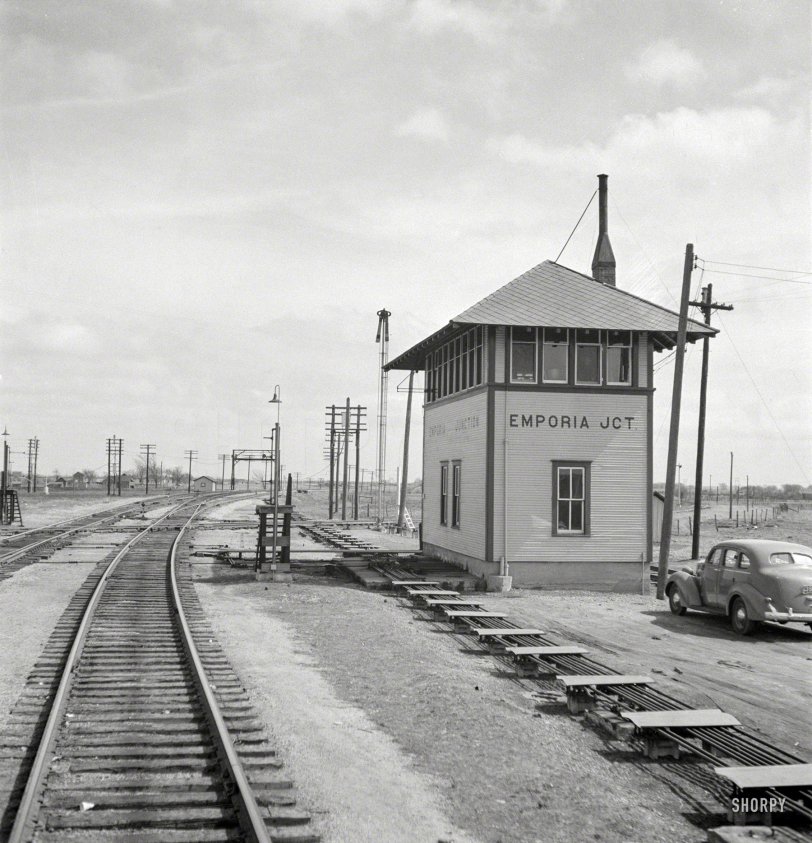


Framed or unframed, desk size to sofa size, printed by us in Arizona and Alabama since 2007. Explore now.
Shorpy is funded by you. Patreon contributors get an ad-free experience.
Learn more.

- Freeze Frame
- Texas Flyer wanted
- Just a Year Too Soon
- WWII -- Replacing men with women at the railroad crossing.
- Yes, Icing
- You kids drive me nuts!
- NOT An Easy Job
- I wonder
- Just add window boxes
- Icing Platform?
- Indiana Harbor Belt abides
- Freezing haze
- Corrections (for those who care)
- C&NW at Nelson
- Fallen Flags
- A dangerous job made worse
- Water Stop
- Passenger trains have right of way over freights?
- Coal
- Never ceases to amaze me.
- Still chuggin' (in model form)
- Great shot
- Westerly Breeze
- For the men, a trapeze
- Tickled
- Sense of loneliness ...
- 2 cents
- Charm City
- What an Outrage
- Brighton Park
Print Emporium
Emporia Junction: 1943

March 1943. "Emporia, Kansas. Passing Emporia Junction switch tower as the Atchison, Topeka & Santa Fe train pulls into the yard." Medium-format negative by Jack Delano for the Office of War Information. View full size.
Kansas
How evocative! I can almost feel the early spring wind blowing.
Computer trains
Many thanks to "signalman" and "LarryDoyle". I lived by yards in Chicago and would occasionally see men at the end of trains throwing switches. I thought that was how it was done, period. To see such a complex integrated system back in the forties....well, I never knew. Thanks once again to Shorpy and followers for this fascinating piece of historical knowledge.
I remember it well!
When I was 18 I worked for British Rail as a conductor guard (as it was known back then) and I remember the tower and having to visit one on my training course. I also remember the old style signals you see in this photo.
One of my tasks as a conductor guard trainee was to alight the tower when one of the signals failed and set off cap detonators on the tracks to warn the oncoming trains.
I never had to do this, fortunately, since the signals were well maintained by the signalmen who religiously made sure they worked well all the time.
Thanks for stirring such wonderful memories.
Track Diagram
Track diagram for Emporia Junction tower along with a bit of history here.
I love Jack Delano train photos
This is where my old head lays as I do miss the big steam days. Gosh, I’m working on a HO brass 4-8-4 Northern right now.
A Solid State computer
- VERY solid! LarryDoyle states the case very well. One minor detail: not all mechanical interlocking machines had their locking vertically below the floor; some had a horizontal 'bed' behind the machine.
This type of interlocking was known colloquially as an 'armstrong' plant - nothing to do with a Mr. (or Mrs.) Armstrong! I can speak from a very mild dose of experience - I am helping to restore such a tower in East Stroudsburg, PA. It is not connected to anything, but even so, my arms get tired.
Mechanical Bits and Bytes
You are looking at the 19th century's equivalent of a computer - mechanical style. That large building, or "tower" is the CPU. Inside, at the operators level upstairs, are several dozen 4 foot long levers - the equivalent of a keyboard for input. One or two of each of these levers is connected by a system of rods and levers, called piping, to control the position of a railroad switch or signal up to half a mile away. This piping can be seen running from the base of the tower, on supporting rollers parallel to the tracks.
At the remote switch, the motion of one lever would set the position of the switch, and the second lever would control a locking mechanism to assure that the switch had thrown properly and to lock it in position so it wouldn't accidentally change position under a moving train.
Downstairs in the tower was a system of vertical movable tappets, one for each lever, with a horizontal matrix of movable locking bars interfaced to the tappets. At the junctions of the tappets and locking bars there were notches cut into the tappets into which dogs on the locking bars could fit to lock or unlock the tappet. Dogs could be set as IF-THEN, OR, XOR, NOR, WHEN, and AND logic, to prevent setting up conflicting routes for train movements through the "interlocking" limits of the plant, and to allow the proper setting of signals to convey routing and speed information to the engineer of an approaching train.
























On Shorpy:
Today’s Top 5